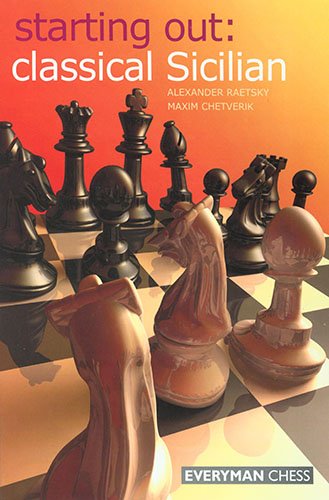The Classical Sicilian is one of Black’s most popular and highly regarded opening choices against 1 e4, and it’s been a favourite of such greats as Vladimir Kramnik, Alexei Shirov and Vishy Anand. White has a number of aggressive ways to battle against the Classical: the fashionable Richter-Rauzer Attack; Bobby Fischer’s favourite, the Sozin Attack; and finally the wild Velimirovic Attack, and no work on the Classical would be complete without a study of these fascinating variations. In this book, Alexander Raetsky and Maxim Chetverik revisit the basics of the Classical Sicilian, elaborating on the crucial early moves and plans for both sides in a way that is often neglected in other texts.
The Everyman Chess Starting Out series has firmly established itself as the leading guide to studying openings for up-and-coming players. These books are distinguished by their easy-to-read layout, the lucid explanations of the fundamentals, and the abundance of notes, tips and warnings to help the reader absorb vital ideas. Starting Out opening books are ideal for enthusiastic chess players who have little experience of the openings in question and who wish to appreciate the essential principles behind them.
About the Author
Russian International Master Maxim Chetverik is a renowned opening theoretician and has co-authored numerous books with Alexander Raetsky.
Alexander Raetsky is a Russian Grandmaster and an experienced competitor on the chess tournament circuit. He’s also a skilled writer and has been a frequent contributor to the famous Russian magazine 64 and the internationally renowned publication New In Chess. His first book for Everyman Chess, Meeting 1 e4, was very well received by reviewers and chess players alike.
Reviews
“There is no definitive work on the Classical Sicilian. The books by Yermolinsky and Raetsky/Chetverik are the ones to choose between. The former is less expensive $19.95 to $24.95 but the former is more up to date ( the author’s list Yermolinsky’s book in their bibliography). Page wise The Everyman book is longer though not so much as the 176 pages to 112 pages difference would suggest as Yermo’s publisher, Gambit, uses a larger format. If you want more explanatory prose Yermo’s book is probably a better bet with that by Raetsky/Chetverik for those who prefer more analysis. Neither book is for club players. Those 2000-2400 would be best served by these books which are neither pure introductory guides or detailing opening tomes.”—John Donaldson, jeremysilman.com
“a player who is just taking up the Classical Sicilian will find this book greatly valuable.”—Chessville.com



